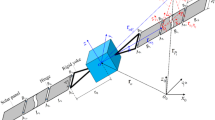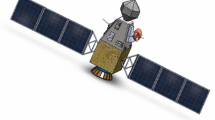Abstract
With extending the Rayleigh–Ritz procedure to study the hub-plate system, the characteristics of global analytical modes are addressed for a typical rigid–flexible coupling dynamic system, i.e., a three-axis attitude stabilized spacecraft installed with a pair of solar arrays. The displacement field of the solar arrays is expressed as a series of admissible functions which is a set of characteristic orthogonal polynomials generated directly by employing Gram–Schmidt process. The rigid body motion of spacecraft is represented by the product of constant and generalized coordinate. Then, through Rayleigh–Ritz procedure, the eigenvalue equation of the three-axis attitude stabilized spacecraft installed with a pair of solar arrays is derived. Solving this eigenvalue equation, the frequencies and analytical expressions of global modes for the flexible spacecraft are obtained. To validate the present analysis, comparisons between the results of the present method and ANSYS software are performed and very good agreement is achieved. The convergence studies demonstrate the high accuracy, excellent convergence and high efficiency of the present approach. Finally, the method is applied to study the characteristics of global modes of the flexible spacecraft.













Similar content being viewed by others
References
Li, J., Yan, S., Cai, R.: Thermal analysis of composite solar array subjected to space heat flux. Aerosp. Sci. Technol. 27, 84–94 (2013)
Foster, C.L., Tinker, M.L., Nurre, G.S., Till, W.A.: Solar-array-induced disturbance of the Hubble Space Telescope pointing system. J. Spacecr. Rockets 32, 634–644 (1995)
Hu, Q., Shi, P., Gao, H.: Adaptive variable structure and commanding shaped vibration control of flexible spacecraft. J. Guid. Control Dyn. 30, 804–815 (2007)
Bang, H., Ha, C.K., Kim, J.H.: Flexible spacecraft attitude maneuver by application of sliding mode control. Acta Astronaut. 57, 841–850 (2005)
Sales, T.P., Rade, D.A., de Souza, L.C.G.: Passive vibration control of flexible spacecraft using shunted piezoelectric transducers. Aerosp. Sci. Technol. 29, 403–412 (2013)
Hu, Q., Ma, G.: Variable structure control and active vibration suppression of flexible spacecraft during attitude maneuver. Aerosp. Sci. Technol. 9, 307–317 (2005)
Lee, K.W., Singh, S.N.: L1 adaptive control of flexible spacecraft despite disturbances. Acta Astronaut. 80, 24–35 (2012)
Karray, F., Grewal, A., Glaum, M., Modi, V.: Stiffening control of a class of nonlinear affine systems. IEEE Trans. Aerosp. Electron. Syst. 33, 473–484 (1997)
Cai, G.P., Lim, C.W.: Dynamics studies of a flexible hub-beam system with significant damping effect. J. Sound Vib. 318, 1–17 (2008)
Dietz, S., Wallrapp, O., Wiedemann, S.: Nodal vs. modal representation in flexible multibody system dynamics. In: Ambrósio JAC (ed.) Multibody Dynamics. IDMEC/IST, Lisbon, Portugal (2003)
Pan, K.Q., Liu, J.Y.: Investigation on the choice of boundary conditions and shape functions for flexible multi-body system. Acta Mech. Sin. 28, 180–189 (2012)
Schwertassek, R., Wallrapp, O., Shabana, A.A.: Flexible multibody simulation and choice of shape functions. Nonlinear Dyn. 20, 361–380 (1999)
Johnston, J.D., Thornton, E.A.: Thermally induced attitude dynamics of a spacecraft with a flexible appendage. J. Guid. Control Dyn. 21, 581–587 (1998)
Hughes, P.C.: Dynamics of flexible space vehicles with active attitude control. Celest. Mech. Dyn. Astron. 9, 21–39 (1974)
Hughes, P.C.: Modal identities for elastic bodies, with application to vehicle dynamics and control. J. Appl. Mech. 47, 177–184 (1980)
Deleuterio, G.M.T., Hughes, P.C: General motion of gyroelastic vehicles in terms of constrained modes. In: 26th Structures, Structural Dynamics, and Materials Conference, Orlando, FL, USA (1985)
Hablani, H: Rotating unconstrained modes: a more appropriate dynamic analysis of flexible spinning spacecraft. In: 22nd Structures, Structural Dynamics and Materials Conference, Atlanta, GA, USA (1981)
Hablani, H.B.: Constrained and unconstrained modes: some modeling aspects of flexible spacecraft. J. Guid. Control Dyn. 5, 164–173 (1982)
Hablani, H.B.: Modal analysis of gyroscopic flexible spacecraft: a continuum approach. J. Guid. Control Dyn. 5, 448–457 (1982)
Hablani, H.B.: Hinges-free and hinges-locked modes of a deformable multibody space station—a continuum analysis. J. Guid. Control Dyn. 13, 286–296 (1990)
Zhang, J., Wang, T.: Coupled attitude-orbit control of flexible solar sail for displaced solar orbit. J. Spacecr. Rockets 50, 675–685 (2013)
Hurty, W.C.: Dynamic analysis of structural systems using component modes. AIAA J. 3, 678–685 (1965)
Craig, R.R., Bampton, M.C.C.: Coupling of substructures for dynamic analyses. AIAA J. 6, 1313–1319 (1968)
Yang, H., Hong, J.Z., Yu, Z.Y.: Vibration analysis and experimental investigation for a typical rigid-flexible coupling system. J. Astronaut. 23, 67–72 (2002)
Liu, L., Cao, D.: Dynamic modeling for a flexible spacecraft with solar arrays composed of honeycomb panels and its proportional-derivative control with input shaper. J. Dyn. Syst. Meas. Control (2016). doi:10.1115/1.4033020
Barbieri, E., Özgüner, U.: Unconstrained and constrained mode expansions for a flexible slewing link. J. Dyn. Syst. Meas. Control 110, 416–421 (1988)
Bellezza, F., Lanari, L., Ulivi, G.: Exact modeling of the flexible slewing link. In: IEEE International Conference on Robotics and Automation, Cincinnati, OH, May 1990. IEEE, pp. 734–739
Kuo, C.F.J., Lin, S.C.: Modal analysis and control of a rotating Euler–Bernoulli beam part I: control system analysis and controller design. Math. Comput. Model. 27, 75–92 (1998)
Bhat, R.B.: Natural frequencies of rectangular plates using characteristic orthogonal polynomials in Rayleigh–Ritz method. J. Sound Vib. 102, 493–499 (1985)
Sun, S., Cao, D., Han, Q.: Vibration studies of rotating cylindrical shells with arbitrary edges using characteristic orthogonal polynomials in the Rayleigh–Ritz method. Int. J. Mech. Sci. 68, 180–189 (2013)
Liu, L., Cao, D., Sun, S.: Vibration analysis for rotating ring-stiffened cylindrical shells with arbitrary boundary conditions. J. Vib. Acoust. 135, 061010 (2013)
Paik, J.K., Thayamballi, A.K., Kim, G.S.: The strength characteristics of aluminum honeycomb sandwich panels. Thin Wall. Struct. 35, 205–231 (1999)
Lachiver, J.M.: Pléiades: operational programming first results. In: SpaceOps 2012 Conference, Stockholm, Sweden, 2012. doi:10.2514/2516.2012-1275526
Hu, Z., Hong, J.: Modeling and analysis of a coupled rigid-flexible system. Appl. Math. Mech. 20, 1167–1174 (1999)
So, J., Leissa, A.W.: Free vibrations of thick hollow circular cylinders from three-dimensional analysis. J. Vib. Acoust. 119, 89–95 (1997)
Zhou, D., Cheung, Y.K., Lo, S.H., Au, F.T.K.: 3D vibration analysis of solid and hollow circular cylinders via Chebyshev–Ritz method. Comput. Meth. Appl. Mech. Eng. 192, 1575–1589 (2003)
Liang, C.C., Liao, C.C., Tai, Y.S., Lai, W.H.: The free vibration analysis of submerged cantilever plates. Ocean Eng. 28, 1225–1245 (2001)
Acknowledgments
This research has been supported by the National Natural Science Foundation of China (Grant No. 11472089).
Author information
Authors and Affiliations
Corresponding author
Rights and permissions
About this article
Cite this article
Liu, L., Cao, D. & Tan, X. Studies on global analytical mode for a three-axis attitude stabilized spacecraft by using the Rayleigh–Ritz method. Arch Appl Mech 86, 1927–1946 (2016). https://doi.org/10.1007/s00419-016-1155-3
Received:
Accepted:
Published:
Issue Date:
DOI: https://doi.org/10.1007/s00419-016-1155-3




